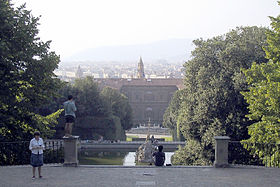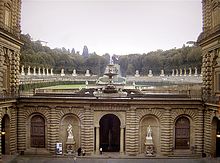Jardin de Boboli / Florence
| Jardin de Boboli | ||
 L'arrière du palais Pitti vu du jardin | ||
| Géographie | ||
|---|---|---|
| Pays | ||
| Commune | Florence | |
| Superficie | 45 000 m² | |
| Localisation | ||
Géolocalisation sur la carte : Florence | ||
| modifier | ||
Le jardin de Boboli (en italien : Giardino di Boboli) est un parc historique de la ville de Florence, adjacent au palais Pitti, de la Porta Romana au Forte Belvedere. Le jardin, bâti sur la colline, qui reçoit chaque année plus de 800 000 visiteurs, est remarquable non seulement pour sa valeur historique et ses paysages, mais aussi pour sa collection de sculptures romaines et florentines des xvie et xviie siècles.
Le jardin, situé derrière le palais Pitti, résidence d'abord des Médicis, puis des Habsbourg-Lorraine et des Savoie, remonte au xvie siècle. Au premier agencement de style Renaissance, visible dans le noyau le plus proche du palais, s'adjoignirent au cours des années de nouvelles parties de style différent : le long de l'axe parallèle au palais furent créées des allées recouvertes de gravillons, de nouveaux plans d'eau et leurs isolotto (petites îles), des fontaines avec des nénuphars, de petits temples et des grottes. Dans ce jardin, les statues et les « fabriques », comme la kaffeehaus ou Casa del Caffè (établie dans un bâtiment construit en 1776 par Zanobi del Rosso en pur style rococo exotique) jouent un rôle remarquable, et permettent de jouir du panorama que le jardin offre sur la ville.
Histoire
Construits pour Éléonore de Tolède, épouse de Cosme Ier de Médicis, les jardins furent commencés par Niccolò Tribolo, qui cependant mourut en 1550, peu de temps après avoir accepté cette charge. Les travaux furent poursuivis par Bartolomeo Ammanati, qui utilisa pour ce projet les contributions de Giorgio Vasari, qui conçut les grottes, et de Bernardo Buontalenti qui sculpta les statues. On doit également à ce dernier l'architecture élaborée de la cour qui sépare le palais du jardin.
L'allée principale rectiligne centrée sur la façade arrière du palais, monte sur la colline de Boboli, traverse un profond amphithéâtre au centre duquel se trouve un obélisque égyptien transporté depuis la Villa Médicis à Rome. Celui-ci était naguère devant le Temple de Rê à Héliopolis, avec son jumeau l'obélisque du monument de Dogali situé à Rome1. Elle se termine à la fontaine de Neptune (surnommée avec irrévérence « Fontaine de la fourche » ou « de la fourchette » par les Florentins, à cause du trident empoigné par Neptune), où la sculpture de Stoldo Lorenzi se détache sur le panorama. Le sommet, près du Forte Belvedere, offre une vue panoramique sur Florence, telle que peinte par Corot (voir l'illustration ci-contre). Une longue allée secondaire partant de l'angle droit de l'axe principal conduit vers une série de terrasses et de fontaines, le Viottolone, l'allée des Cyprès.
Au cours de la première phase des travaux, l'amphithéâtre fut creusé dans la colline derrière le palais. Amphithéâtre de verdure à l'origine, cloisonné par des bosquets toujours verts, il fut par la suite formalisé, reconstruit en maçonnerie et décoré de statues illustrant la mythologie romaine. La Grotticina della Madama, et la Grande Grotte sont achevées par Buontalenti entre 1583 et 1593.
Les statues de la Grande grotte sont un exemple remarquable de l'architecture et de la culture maniériste. Décorée à l'intérieur et à l'extérieur de stalactites, dotée de jeux d'eau et de végétation luxuriante, la Grande grotte est subdivisée en trois parties principales. La première fut couverte de fresques destinées à créer l'illusion d'une grotte naturelle dans laquelle les bergers se réfugiaient pour se défendre des bêtes sauvages. Elle abritait aussi Les Prisonniers (ou Les Esclaves) de Michel-Ange (aujourd'hui remplacés par une copie), des statues inachevées créées à l'origine pour le Tombeau de Jules II. Les autres salles abritent la Vénus sortant du bain de Jean de Bologne et le groupe de Paris et Hélène sculpté par Vincenzo de Rossi au xvie siècle.
De nombreuses fontaines :
- la fontaine de Neptune de Stoldo Lorenzi de 1568 (1565 pour la statue de Neptune)
- la fontaine de Jupiter
- la fontaine de l'artichaut de Giovanni Francesco Susini (it) et de Francesco del Tadda (it) de 1641
- la fontaine de l'Océan de Jean de Bologne placée au milieu de l'Isolotto du lac de 1576
- la fontaine du petit Bacchus (Fontana del Bacchino) (1560), en fait la statue du nain Morgante, favori de Cosme Ier, qui est l'œuvre la plus connue de Valerio Cigoli.
Beaucoup d'autres statues allégoriques dans le jardin comme Prudence, Esculape, l'Automne, l'Été, Faune et Jupiter sont de Giovanni Battista Caccini ; trois figures grotesques représentant Venere, Amore e la personificazione dell'Architettura de Romolo del Tadda et, sur son modèle, le Gioco del Saccomazzone d'Orazio Mochi.
C'est dans ces jardins qu'on cultivera pour la première fois la patata, la pomme de terre et aussi des mûriers, des poiriers nains et d'autres fruits exotiques2 ramenés du monde entier.
============================================================
Boboli Gardens
| Boboli Gardens | |
|---|---|
 The main axis through the anfiteatro centered on Palazzo Pitti | |
 | |
| Type | Pleasure garden |
| Location | Florence, Italy |
| Coordinates | 43°45′45″N 11°14′54″E |
| Area | 45,000 square metres (11 acres) |
| Website | www |
The Boboli Gardens (Italian: Giardino di Boboli) is a historical park of the city of Florence that was opened to the public in 1766. Originally designed for the Medici, it represents one of the first and most important examples of the Italian garden, which later served as inspiration for many European courts. The large green area is a real open-air museum with statues of various styles and periods, ancient and Renaissance that are distributed throughout the garden. It also has large fountains and caves, among them the splendid Buontalenti grotto built by the artist, architect and sculptor Bernardo Buontalenti between 1536 and 1608.
History and layout
The Gardens, directly behind the Pitti Palace, the main seat of the Medici grand dukes of Tuscany at Florence, are some of the first and most familiar formal 16th-century Italian gardens. The mid-16th-century garden style, as it was developed here, incorporated longer axial developments, wide gravel avenues, a considerable "built" element of stone, the lavish employment of statuary and fountains, and a proliferation of detail, coordinated in semi-private and public spaces that were informed by classical accents: grottos, nympheums, garden temples and the like. The openness of the garden, with an expansive view of the city, was unconventional for its time. The gardens were very lavish, considering no access was allowed to anyone outside the immediate Medici family, and no entertainment or parties ever took place in the gardens.
The Boboli Gardens were laid out for Eleonora di Toledo, the wife of Cosimo I de' Medici.[1] The name may be a corruption of "Bogoli" [2] or "Borgoli", [3] possibly a family who had previously owned the land. [4] The first stage was scarcely begun by Niccolò Tribolo[1] before he died in 1550, then was continued by Bartolomeo Ammanati, with contributions in planning from Giorgio Vasari, who laid out the grottos, and in sculpture by Bernardo Buontalenti.[5] The elaborate architecture of the grotto in the courtyard that separates the palace from its garden is by Buontalenti.
The garden lacks a natural water source. To water the plants in the garden, a conduit was built from the nearby Arno River to feed water into an elaborate irrigation system.[1]
The primary axis, centered on the rear façade of the palace, rises on Boboli Hill from a deep amphitheater[5] that is reminiscent in its shape of one half of a classical hippodrome or racecourse. At the center of the amphitheater and rather dwarfed by its position is the Ancient Egyptian Boboli obelisk[1] brought from the Villa Medici at Rome. This primary axis terminates in a fountain of Neptune (known to the irreverent Florentines as the "Fountain of the Fork" for Neptune's trident), with the sculpture of Neptune by Stoldo Lorenzi visible against the skyline as a visitor climbs the slope.
Giulio Parigi laid out the long secondary axis, the Viottolone or Cyprus Road at a right angle to the primary axis. This road led up through a series of terraces and water features, the main one being the Isolotto complex, with the bosquets on either side, and then allowed for exit from the gardens almost at Porta Romana, which was one of the main gates of the walled city. In 1617, Parigi constructed the Grotto of Vulcan (Grotticina di Vulcano) along this axis.
The gardens have passed through several stages of enlargement and restructuring work. They were enlarged in the 17th century to their present extent of 45,000 meters² (111 acres).[5] The Boboli Gardens have come to form an outdoor museum of garden sculpture that includes Roman antiquities as well as 16th and 17th century works.
In the first phase of building, the amphitheatre was excavated in the hillside behind the palace. Initially formed by clipped edges and greens, it was later formalized by rebuilding in stone decorated with statues based on Roman myths such as the Fountain of the Ocean sculpted by Giambologna, then transferred to another location within the same garden. The small Grotto of Madama, and the Large Grotto, were begun by Vasari and completed by Ammannati and Buontalenti between 1583 and 1593.[5]
Even while undergoing restoration work in 2015, the Large Grotto's statues are still on display and represent defining examples of Mannerist sculpture and architecture. Decorated internally and externally with stalactites and originally equipped with waterworks and luxuriant vegetation, the fountain is divided into three main sections. The first one was frescoed to create the illusion of a natural grotto, that is a natural refuge to allow shepherds to protect themselves from wild animals; it originally housed The Prisoners of Michelangelo (now replaced by copies), statues that were first intended for the tomb of the Pope Julius II. Other rooms in the Grotto contain Giambologna's famous Bathing Venus and an 18th-century group of Paris and Helen by Vincenzo de' Rossi.
The Fountain of Neptune
In the hillside above the amphitheatre is a double ramp, leading to the Fountain of Neptune. The main feature is a large basin with a central bronze statue of Neptune (1565-1568) by Stoldo Lorenzi. This fountain was being constructed contemporaneously with it more famous counterpart, Ammannati's Fountain of Neptune at the corner of the Palazzo Vecchio at the Piazza della Signoria in the center of Florence. The conceit here recalls the story of the competition of Athena and Neptune to be patrons of Athens. In that legend, Neptune struck the ground with his trident to spring forth water from the land. Higher up on the hillside is a statue of Abundance (Dovizia).[6]
The Isolotto
The Isolotto is an oval-shaped island in a tree enclosed pond nearly at the end of the alternative Viottolone axis. In the centre of the island is the Fountain of the Ocean, while in the surrounding moat, there are statues of Perseus and Andromedae (school of Giambologna). The Isolotto was laid out (circa 1618) by Giulio and Alfonso Parigi.



















